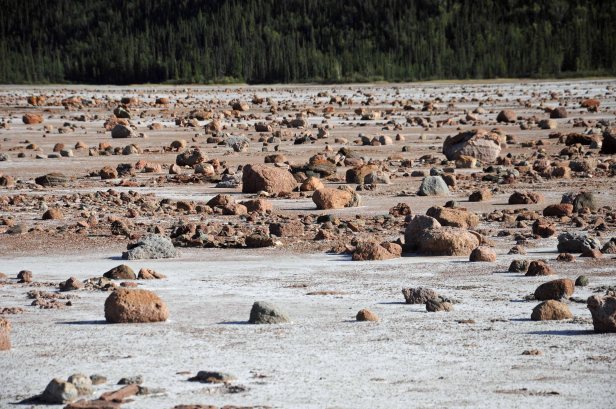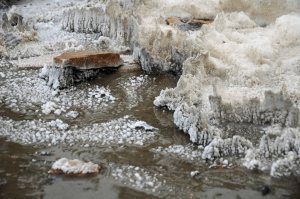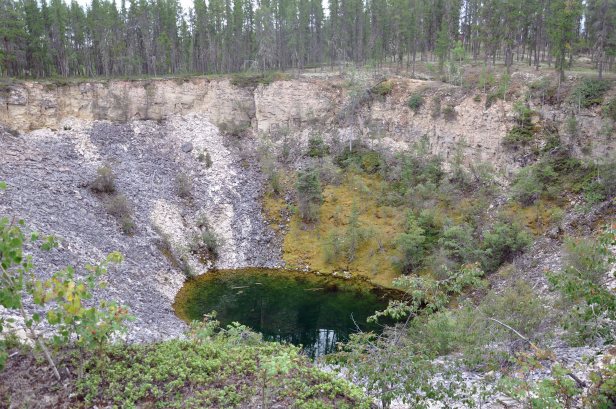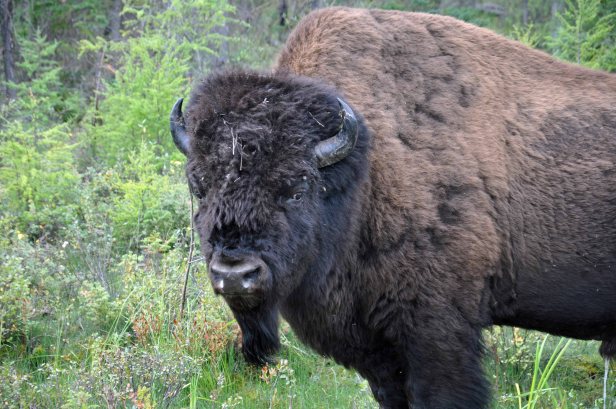We, in Canada, are all thinking of the tragic fire in Fort McMurray, Alberta. I have never been there but I was in Wood Buffalo National Park, located a few hundred kilometers directly north of Fort McMurray. I wanted to share a strange part of this wonderful earth we live on. I thought I had stepped onto another planet.

I was in Wood Buffalo National Park, when I saw the most striking and eerily strange landscapes on earth. They call it Grosbeak Lake but most of the water is gone. The salt flats are what remain of the huge inland sea that once covered much of northern Canada.

The lake is covered with corroded rocks and boulders which were carried from the Precambrian Shield in the last Ice Age. Over time, the salt, frost and wind have weathered the rocks into wonderful shapes. In some places, it appears that a huge boulder has dissolved leaving a ring of pebbles.
Wood Buffalo National Park, is located in Northeastern Alberta and Southern North West Territories. It is Canada’s largest national park and one of the largest in the world. Established in 1922 to protect the free-roaming bison herds of the area, it was designated a UNESCO World Heritage Site in 1983.
The area is know for its Karst topography, which is characterized by underground drainage systems with sinkholes and caves.

There are lots of hiking trails in the park and it is well worth the visit. They even have a large herd of wood buffalo as well as one of the last natural breeding grounds for the whooping Crane. It is a very strange place on this Earth







what a fascinating place! it seems that i have seen more of Europe than of Canada…. must work on that 🙂
LikeLike
Yes, it is fascinating and you should travel around if you can… Canada is such a varied and vast land. I have been to all provinces and of the territories… just have to get to Nunavut.
LikeLiked by 1 person
Beautiful photos! Wood Buffalo National Park is such a strangely unique place.I went there years ago. However, after seeing these pictures, I may need to make another trip.
LikeLiked by 1 person
There is so much to see in the north of Canada.. I love it.
LikeLiked by 1 person
Unfortunately that is the farthest north I have ever been. I would love to venture more into the territories though. I have heard that it is spectacularly beautiful up there.
LikeLike
Excellent!!!
Galen
LikeLiked by 1 person
Amazing place. Thanks for sharing about it, otherwise I would never have known it existed.
LikeLike
I love discovering all the weird and wonderful places on this world we live on
LikeLike
Really beautiful shots!
LikeLike
awesome………. 🙂
LikeLike
Love nature Photography. Nice Shots.
LikeLike
Amazing natural history. Thank you for sharing this beautiful corner of the earth.
LikeLiked by 1 person
Not a lot of people visit the far north. It is worth the trip
LikeLiked by 1 person
Amazing landscape Maggie, and that’s some size sinkhole!!! Ours in the UK are gereally a couple of feet across!! BTW, the photos are great, especially the wood buffalo 🙂
LikeLiked by 1 person
That was an amazing 4 month road trip to the Arctic and back… So diverse and unpopulated really.
LikeLiked by 1 person
It certainly looks amazing! Were you up in the Artic during the summer?
LikeLike
Yes, we have relatives in Inuvik on the Mckenzie River. It was wonderfully hot and sunny… And we enjoyed watching the sun set… At 1 am.. The dusk last all night.. But in the winter, it’s too cold and dark for me. (Although it’s on my bucket list to experience the northern lights from above the arctic circle.
LikeLiked by 1 person
I hadn’t heard of Inuvik, so I just looked it up on Google maps, I hadn’t realised people lived that far north in Canada. Experiencing perpetual daylight must be brilliant, but like you, I’m not sure that I could cope with there winters! Or the lack of hills! It looked so flat ……………. and I thought Cornwall had a lack of proper trees! Lol! 🙂
I might be a little bit too curious, but why are there settlements that far north? I love being in the countryside, away from the hustle and bustle of our towns and cities, but living in somewhere like Inuvik would be way too quiet for me! Lol! 🙂
LikeLike
The town is small, and was literally built from scratch in the 50’s. It is built on permafrost, so every building is on piles. Quite a sight. Oil and gas industry and the military are there as well as natives. My family are all connected with the small college there. There is a lot of research based there too.
LikeLiked by 1 person
I thought it looked a fairly recently built place, Maggie, and had wondered about whether oil & gas might be a reason for its location. I imagine the research that goes on up there would be really fascinating. It must be a really close knit community, working at the college would be great because you would know everyone 🙂
LikeLiked by 1 person
Yes, they love living up there even when the winters have no sun and the temperatures are -30c or colder.
LikeLiked by 1 person